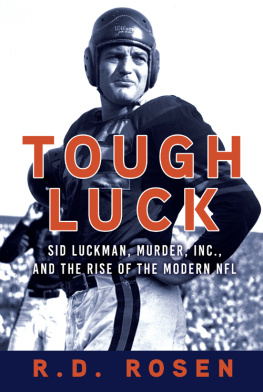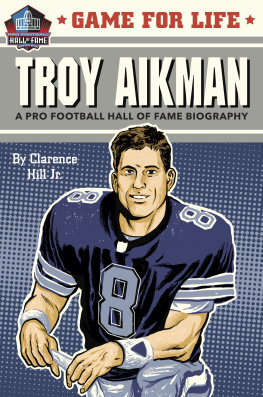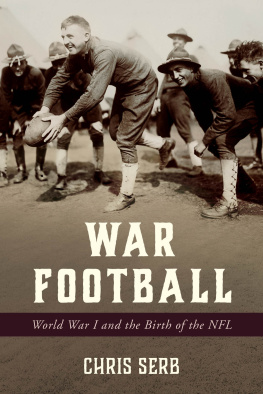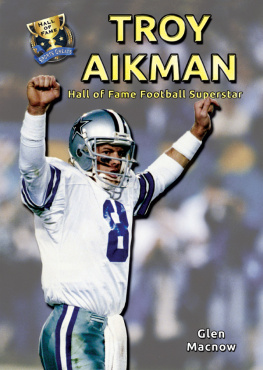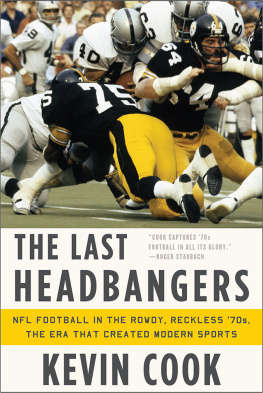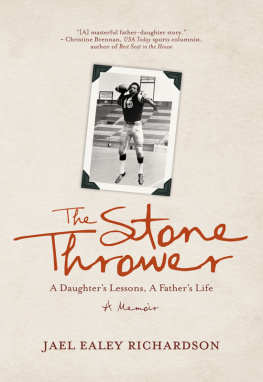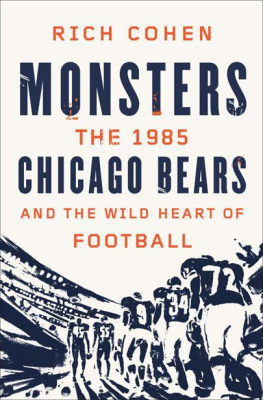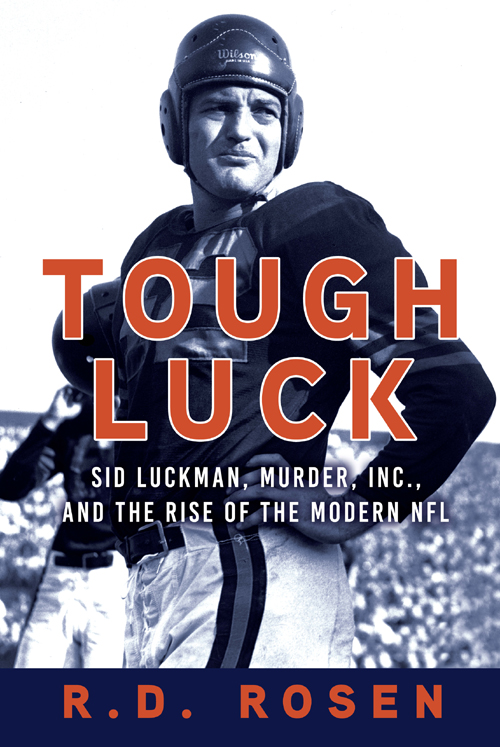NONFICTION
Such Good Girls: The Journey of the Holocausts Hidden Child Survivors
A Buffalo in the House: The True Story of a Man, an Animal, and the American West
Psychobabble: Fast Talk and Quick Cure in the Era of Feeling
Me and My Friends, We No Longer Profess Any Graces:
A Premature Memoir
MYSTERY NOVELS
Strike Three Youre Dead
Fadeaway
Saturday Night Dead
World of Hurt
Dead Ball
HUMOR
Not Available in Any Store:
The Complete Catalog of the Most Amazing Products Never Made
With Harry Pritchett and Rob Battles:
Bad Cat
Bad Dog
Bad Baby
Bad President
Throw the Damn Ball:
Classic Poetry by Dogs
TOUGH LUCK
SID LUCKMAN, MURDER, INC., AND THE RISE OF THE MODERN NFL
R.D. ROSEN

Copyright 2019 by Richard Dean Rosen
Cover design by Becca Fox Design
Cover photograph Nate Fine/Getty Images
All rights reserved. No part of this book may be reproduced in any form or by any electronic or mechanical means, including information storage and retrieval systems, without permission in writing from the publisher, except by a reviewer, who may quote brief passages in a review. Scanning, uploading, and electronic distribution of this book or the facilitation of such without the permission of the publisher is prohibited. Please purchase only authorized electronic editions, and do not participate in or encourage electronic piracy of copyrighted materials. Your support of the authors rights is appreciated. Any member of educational institutions wishing to photocopy part or all of the work for classroom use, or anthology, should send inquiries to Grove Atlantic, 154 West 14th Street, New York, NY 10011 or permissions@groveatlantic.com.
FIRST EDITION
Published simultaneously in Canada
Printed in Canada
This book was set in 12.5-pt. Centaur MT by Alpha Design & Composition of Pittsfield, NH.
First Grove Atlantic hardcover edition: September 2019
Library of Congress Cataloging-in-Publication data is available for this title.
ISBN 978-0-8021-2944-4
eISBN 978-0-8021-4711-0
Atlantic Monthly Press
an imprint of Grove Atlantic
154 West 14th Street
New York, NY 10011
Distributed by Publishers Group West
groveatlantic.com
19 20 21 22 10 9 8 7 6 5 4 3 2 1
In memory of Robert Baskin Rosen, brother in every sense
Sometimes you find the panel, but it doesnt open; sometimes it opens, and your gaze meets nothing but a mouse skeleton. But at least youve looked. Thats the real distinction between people: not between those who have secrets and those who dont, but between those who want to know everything and those who dont. This search is a sign of love, I maintain.
Julian Barnes, Flauberts Parrot
In 1959, when I was 10 years old, I was fascinated by the new occupants of a big redbrick colonial house around the corner from my familys quirky custom split-level. Word had spread quickly throughout Highland Park, our suburb on the North Shore of Chicago, that the new occupants were former Chicago Bears quarterback Sid Luckman and his family.
This was of particular interest to me, since I had recently become a rabid Chicago Bears fan. An embarrassing amount of my mental and emotional life was consumed by the team and its fortunes. My most noticeable talent in those days was my drawing ability, and my school notebooks were filled with pictures of football players and the hash-marked turf at Wrigley Field, where the Bears played their home games until 1971. On autumn Sunday mornings, while I fidgeted in confirmation class at Congregation Solelour activist Reform rabbi had temporarily stopped believing in the bar mitzvahI emerged from my football reveries only long enough to write an occasional essay about the nonexistence of God. Judaism was my faith, but the Chicago Bears were my religion.
And Sid Luckman was professional footballs Moses, having led the Bears, the first modern pro football dynasty, to the promised land. Although I was too young to have seen Luckman play, his legendary status was reinforced every time I heard fans of my fathers generation exclaimusually when one of Luckmans lesser successors overthrew an open receiverWheres Sid Luckman when we need him? The great quarterback presided over my obsession with the Bears, even though I was too young to appreciate, or even know about, his specific deeds. Only later would I learn that he had once led the most feared team in the National Football Leaguethe Monsters of the Midwayto five national championship appearances and four titles in seven years during the 1940s; that in his first year as starting quarterback, the Bears had manhandled the Washington Redskins 730, still and probably forever the most lopsided victory in NFL history; that Sid Luckman was the first man to throw seven touchdown passes in a game and the first to throw for more than 400 yards; and that he held the record for the highest percentage of passes in a single season that went for touchdowns. Despite the rapid evolution of the passing game, most of Luckmans several team records wouldnt be broken for 65 years.
More important, however, was this: the intricate T-formation offense he spearheaded had ushered in the modern era of pro football, elevating a sport that had been the grimy sideshow to the more popular rah-rah college game. This historical achievement was memorialized in the Bears fight song, Bear Down, Chicago Bears: Well never forget the way you thrilled the nation / With your T formation. If the song was catchier than most, that was because it was written by the man who had already penned Bibbidi-Bobbidi-Boo and A Dream Is a Wish Your Heart Makes for Disneys movie Cinderella.
I knew the words by heart because I was lucky enough to go to several Chicago Bears games in the late 1950s and 1960s, when the song was blared scratchily over the loudspeaker. Of all the memorable experiences of my childhood, nothing captured my imagination quite like Bears games at Wrigley Field. In those media-deprived days, before home games were even televised, attending a Bears game was a rare glimpse of a special kingdom full of pageantry and armed battle. As my father and I walked up North Sheffield Avenue, the air crackled with the pregame chatter of Jack Brickhouse and his sidekick, newspaper columnist/color man Irv Kupcinet, pouring out of hundreds of Sony transistor radiosa new phenomenon. And now we were through the clicking turnstiles and mounting Wrigleys ramps until the scene was revealed in all its glory: the brilliant green turf; the meticulously limed lines; the fans in their seats already unscrewing their thermoses of coffee and nipping from their flasks to stay warm; the ivy on Wrigleys outfield walls turning brown, yellow, and orange, or gone altogether, leaving a spindly network of vines stuck to the brick. Most exciting of all were the Bears players themselves, warming up, military in their navy-blue jerseys and helmets and immaculate white pants; immense in their shoulder pads; practicing passes, pinwheeling placekicks, and high revolving punts; running phantom plays under the cold sun. And everything was in saturated color, not the faded hues of our first Zenith color television.

